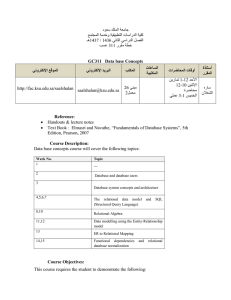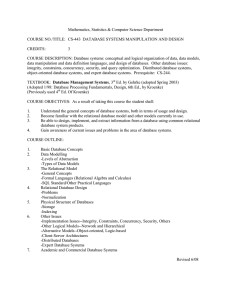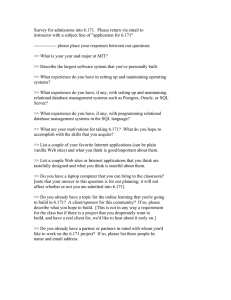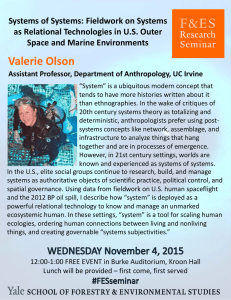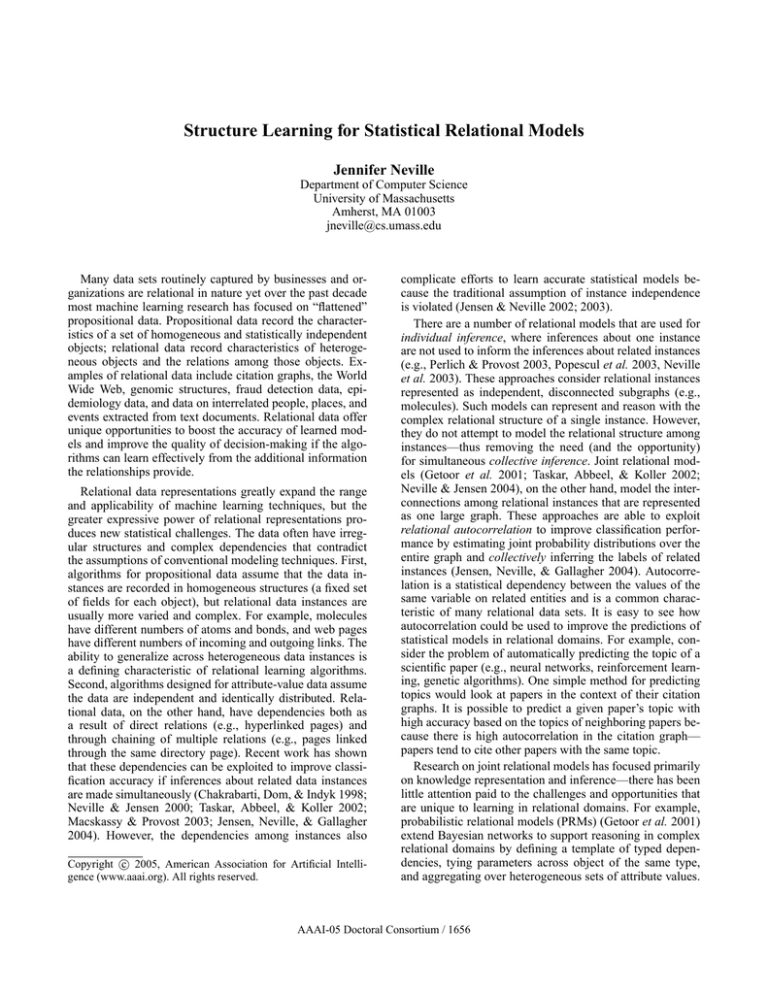
Structure Learning for Statistical Relational Models
Jennifer Neville
Department of Computer Science
University of Massachusetts
Amherst, MA 01003
jneville@cs.umass.edu
Many data sets routinely captured by businesses and organizations are relational in nature yet over the past decade
most machine learning research has focused on “flattened”
propositional data. Propositional data record the characteristics of a set of homogeneous and statistically independent
objects; relational data record characteristics of heterogeneous objects and the relations among those objects. Examples of relational data include citation graphs, the World
Wide Web, genomic structures, fraud detection data, epidemiology data, and data on interrelated people, places, and
events extracted from text documents. Relational data offer
unique opportunities to boost the accuracy of learned models and improve the quality of decision-making if the algorithms can learn effectively from the additional information
the relationships provide.
Relational data representations greatly expand the range
and applicability of machine learning techniques, but the
greater expressive power of relational representations produces new statistical challenges. The data often have irregular structures and complex dependencies that contradict
the assumptions of conventional modeling techniques. First,
algorithms for propositional data assume that the data instances are recorded in homogeneous structures (a fixed set
of fields for each object), but relational data instances are
usually more varied and complex. For example, molecules
have different numbers of atoms and bonds, and web pages
have different numbers of incoming and outgoing links. The
ability to generalize across heterogeneous data instances is
a defining characteristic of relational learning algorithms.
Second, algorithms designed for attribute-value data assume
the data are independent and identically distributed. Relational data, on the other hand, have dependencies both as
a result of direct relations (e.g., hyperlinked pages) and
through chaining of multiple relations (e.g., pages linked
through the same directory page). Recent work has shown
that these dependencies can be exploited to improve classification accuracy if inferences about related data instances
are made simultaneously (Chakrabarti, Dom, & Indyk 1998;
Neville & Jensen 2000; Taskar, Abbeel, & Koller 2002;
Macskassy & Provost 2003; Jensen, Neville, & Gallagher
2004). However, the dependencies among instances also
c 2005, American Association for Artificial IntelliCopyright gence (www.aaai.org). All rights reserved.
complicate efforts to learn accurate statistical models because the traditional assumption of instance independence
is violated (Jensen & Neville 2002; 2003).
There are a number of relational models that are used for
individual inference, where inferences about one instance
are not used to inform the inferences about related instances
(e.g., Perlich & Provost 2003, Popescul et al. 2003, Neville
et al. 2003). These approaches consider relational instances
represented as independent, disconnected subgraphs (e.g.,
molecules). Such models can represent and reason with the
complex relational structure of a single instance. However,
they do not attempt to model the relational structure among
instances—thus removing the need (and the opportunity)
for simultaneous collective inference. Joint relational models (Getoor et al. 2001; Taskar, Abbeel, & Koller 2002;
Neville & Jensen 2004), on the other hand, model the interconnections among relational instances that are represented
as one large graph. These approaches are able to exploit
relational autocorrelation to improve classification performance by estimating joint probability distributions over the
entire graph and collectively inferring the labels of related
instances (Jensen, Neville, & Gallagher 2004). Autocorrelation is a statistical dependency between the values of the
same variable on related entities and is a common characteristic of many relational data sets. It is easy to see how
autocorrelation could be used to improve the predictions of
statistical models in relational domains. For example, consider the problem of automatically predicting the topic of a
scientific paper (e.g., neural networks, reinforcement learning, genetic algorithms). One simple method for predicting
topics would look at papers in the context of their citation
graphs. It is possible to predict a given paper’s topic with
high accuracy based on the topics of neighboring papers because there is high autocorrelation in the citation graph—
papers tend to cite other papers with the same topic.
Research on joint relational models has focused primarily
on knowledge representation and inference—there has been
little attention paid to the challenges and opportunities that
are unique to learning in relational domains. For example,
probabilistic relational models (PRMs) (Getoor et al. 2001)
extend Bayesian networks to support reasoning in complex
relational domains by defining a template of typed dependencies, tying parameters across object of the same type,
and aggregating over heterogeneous sets of attribute values.
AAAI-05 Doctoral Consortium / 1656
Relational Markov networks (RMNs) (Taskar, Abbeel, &
Koller 2002) extend Markov networks in a similar manner,
with typed clique templates, parameter tying, and aggregations over probabilities rather than values. Within these extended representations, conventional propositional learning
techniques are used for both parameter estimation and structure learning.
This approach is a good first step but there are a number of limitations to using propositional learning techniques
in a relational setting. First, dependencies among instances,
combined with varying relational structure, will increase the
variance of parameter estimates (Jensen & Neville 2002).
This inefficiency in parameter estimation will cause the
learning algorithms to overfit and may result in biased structure learning. One solution is to use a non-selective model,
that is, a model that doesn’t do feature selection. However,
for relational tasks, which are likely to have a large number
of features, this lack of selectivity will make the model more
difficult to interpret and will increase the computational burden for inference. Second, the search space is potentially
much larger than in propositional domains, making conventional generate-and-test approaches to structure learning
intractable. When the data are propositional, the possible
dependencies are exponential in the number of attributes.
When the data are relational, the possible dependencies are
exponential in the number of attributes and the number of instances. Third, restrictions to the model space to make structure learning tractable, generally involve a change in representation that presents a chicken and egg problem. Representation can impair the ability to learn important knowledge,
but knowing the right representation often requires just that
knowledge. To date there has been little work that has explored this issue.
This work will consider in depth the issue of structure
learning in statistical relational models. There are three aspects to developing accurate and efficient structure learning techniques: (1) hypothesis testing, (2) structuring the
search space, and (3) efficient search of the space. We propose to develop accurate hypothesis testing techniques that
will adjust for the widely varying structure and dependencies among instances in relational data. In addition, we will
investigate approaches to structuring the search space, offering alternatives to the current naive approach of generalto-specific ordering, which will break down as the data complexity grows. Specifically, we will consider a view-learning
approach, which uses predicate invention to decouple the
search space into a set of biased abstractions, allowing the
search to consider a wider range of dependencies. Finally,
we propose to develop more efficient search techniques for
model selection. By interleaving structure learning, parameter estimation, and inference, we will constrain the search
using the structure of data in a bottom-up fashion.
Our work to date has identified a number of key characteristics in relational data (e.g., heterogeneous relational structure, autocorrelation), their adverse effects on learning, and
initial strategies to adjust for these characteristics (Jensen &
Neville 2002; 2003). This work will be extended to analyze
hypothesis testing techniques used in learning directed and
undirected joint models, and to develop accurate structure
learning techniques for these models. In addition, we are
currently investigating abstractions that decouple structure
and attribute dependencies with latent groups as a means
to structure the search space. This work will be combined
with our investigation of the properties of aggregation techniques (Neville, Jensen, & Gallagher 2003) and approximation techniques (Neville & Jensen 2004) to develop accurate
and efficient search techniques for relational domains.
This work is positioned to extend the range, applicability,
and performance gains of joint statistical relational models.
A sufficient number of relational representations have been
developed to start generalizing their characteristics and extending their performance. The models have been successfully applied in a number of domains, including the World
Wide Web, genomic structures, and citation graphs, but
progress is hindered by the complexity of learning and inference. If we do not focus on techniques for structure learning in relational models, we risk learning models with uninterpretable structure, poor generalization, and inefficient
performance. The benefits of accurate and efficient structure
learning are two-fold. First, in small datasets, where we have
the computational resources to apply current learning and
inference techniques, improved structure learning will increase the accuracy of the models. Second, in large datasets,
where learning and inference are computationally intensive,
if not intractable, improved structure learning will make relational modeling both practical and feasible.
References
Chakrabarti, S.; Dom, B.; and Indyk, P. 1998. Enhanced hypertext
categorization using hyperlinks. In SIGMOD-1998, 307–318.
Getoor, L.; Friedman, N.; Koller, D.; and Pfeffer, A. 2001. Learning probabilistic relational models. In Relational Data Mining.
Springer-Verlag.
Jensen, D., and Neville, J. 2002. Linkage and autocorrelation
cause feature selection bias in relational learning. In ICML-2002.
Jensen, D., and Neville, J. 2003. Avoiding bias when aggregating
relational data with degree disparity. In ICML-2003, 274–281.
Jensen, D.; Neville, J.; and Gallagher, B. 2004. Why collective
inference improves relational classification. In SIGKDD-2004.
Macskassy, S., and Provost, F. 2003. A simple relational classifier.
In KDD-2003 Workshop on Multi-Relational Data Mining.
Neville, J., and Jensen, D. 2000. Iterative classification in relational data. In AAAI-2000 Workshop on Learning Statistical
Models from Relational Data.
Neville, J., and Jensen, D. 2004. Dependency networks for relational data. In ICDM-2004.
Neville, J.; Jensen, D.; Friedland, L.; and Hay, M. 2003. Learning
relational probability trees. In ACM SIGKDD-2003, 625–630.
Neville, J.; Jensen, D.; and Gallagher, B. 2003. Simple estimators
for relational Bayesian classifers. In ICDM-2003.
Perlich, C., and Provost, F. 2003. Aggregation-based feature invention and relational concept classes. In KDD-2003.
Popescul, A.; Ungar, L.; Lawrence, S.; and Pennock, D. 2003.
Statistical relational learning for document mining. In ICDM2003.
Taskar, B.; Abbeel, P.; and Koller, D. 2002. Discriminative probabilistic models for relational data. In UAI-2002.
AAAI-05 Doctoral Consortium / 1657

